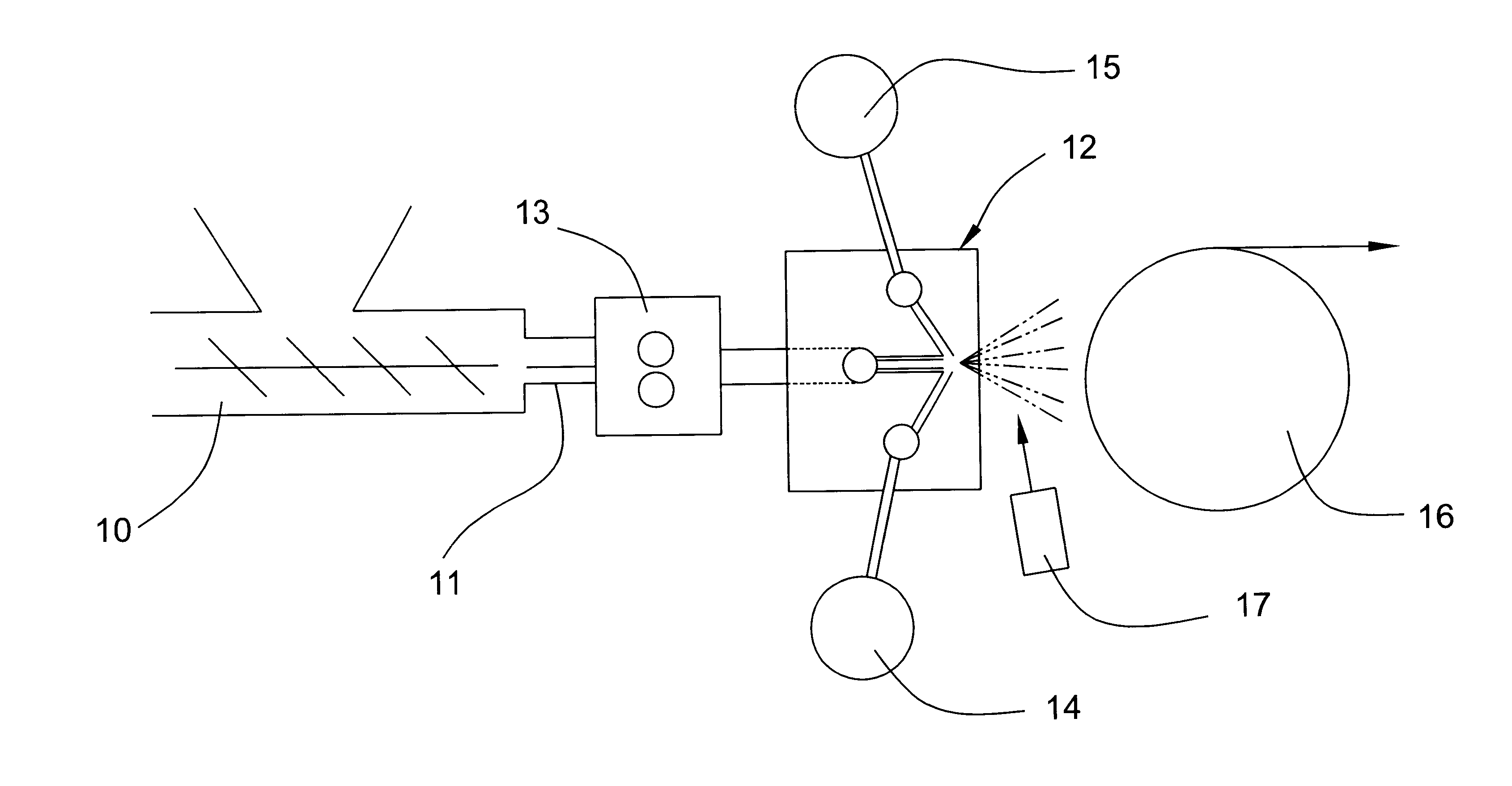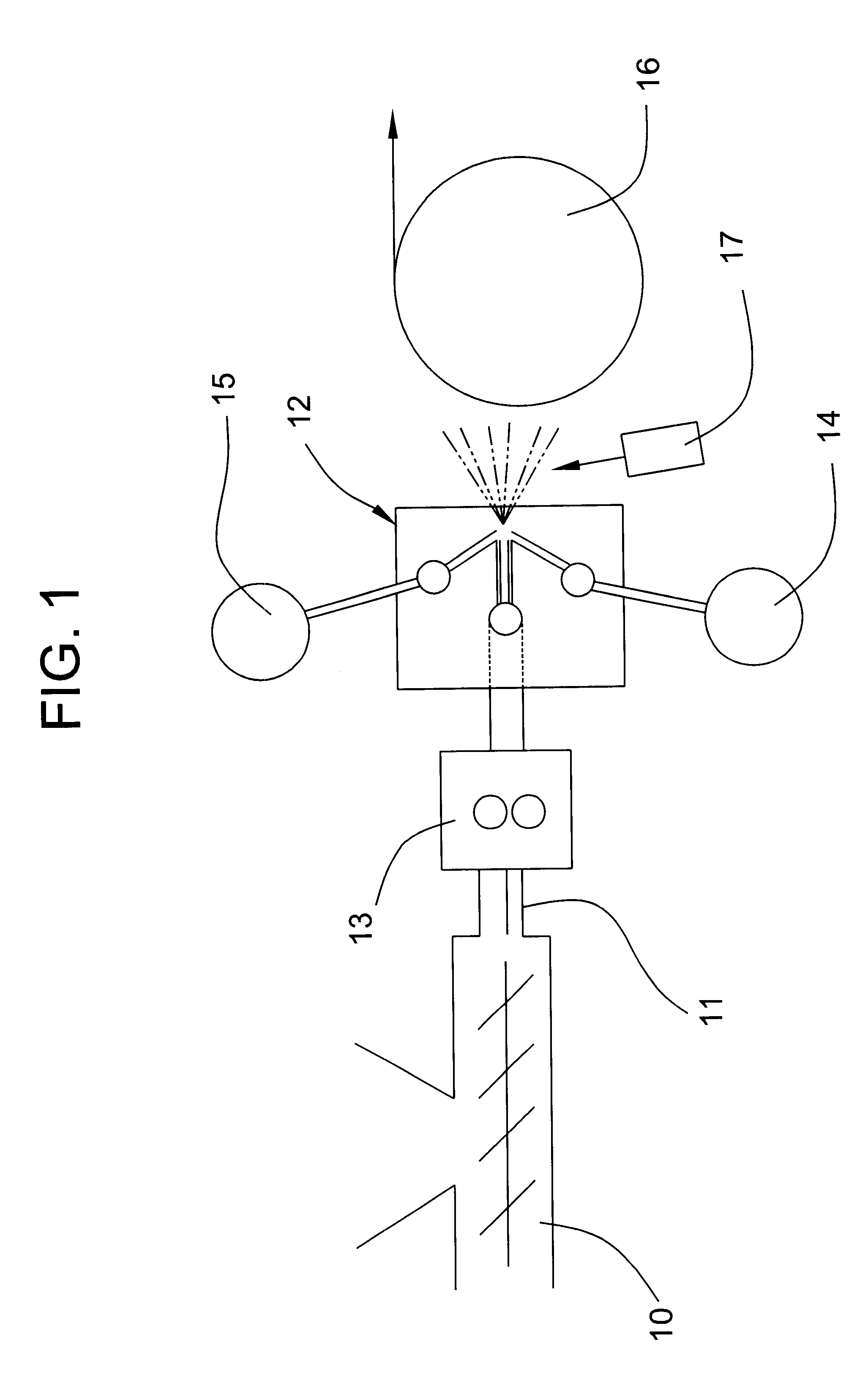Process for preparing a non-woven fibrous web
- Summary
- Abstract
- Description
- Claims
- Application Information
AI Technical Summary
Benefits of technology
Problems solved by technology
Method used
Image
Examples
example 2
Polypropylene Web
A polypropylene web was prepared as per example 1, except that the angle of the spray manifold was changed to about 10-15.degree. towards the extrusion manifold. An attempt was made to spray the cooling fluid as close as possible to the exit point of the fibers from the extrusion manifold, while trying to minimize the spray that actually contacted the manifold. It was readily apparent that this modification significantly improved the capsule adhesion. Visible overspray was virtually eliminated, and the spray mist could actually be seen to follow the web. The predicted final basis weight was 72.66 g / m.sup.2, while the final measured basis weight was 27.3 g / m.sup.2. While the discrepancy between the predicted and final basis weight is not well understood, it was noted that the weight of the capsules increased the weight of the web by about 10% over the final weight measured in Example 1. SEM photographs provided visual confirmation of significant capsule adhesion.
example 3
Polypropylene Web
A polypropylene web was prepared as per Example 1, except the line speed was decreased to 14 fpm to increase the dwell time of the web in the capsule spray mist. The predicted untreated web weight was calculated to be 92.4 g / m.sup.2, while the actual final basis weighted was 44.9 g / m.sup.2. Again, this discrepancy is not well understood.
For the example, the capsule spray was introduced, with the spray manifold used in a position of 10-15.degree. off vertical toward the extrusion manifold. The predicted final basis weight of the product was calculated to be 150.51 g / m.sup.2. The actual basis weight of the web was 52.7 g / m.sup.2. Thus, although the discrepancy between predicated and actual basis weights is not well understood, the weight of the web increased by 17% via the addition of the capsules. SEM photographs provided visual confirmation of the capsule adhesion.
example 4
Nylon Web
In this example, a nylon 6 web was prepared. It was believed that nylon 6 was a more "sticky" polymer then polypropylene, and that capsule addition would therefore be enhanced.
The barrel zone extruder temperature, the die zone temperature, and the air furnace temperature were all raised to 580.degree. F. The DCD was increased to 17 in., and the hole flow rates were decreased to 0.26 gal / hr. The air pressure at the extrusion tips was increased to 4 psi.
An untreated nylon web was prepared at a line speed of 14 ft / min. The predicted base weight of the web was estimated to be 60.1 g / m.sup.2, which is in good agreement with the actual measured basis weight of 58.4 g / m.sup.2.
For the example, the line speed was increased to 29 fpm. It was believed that the increase in line speed decreased the basis weight of the web. The predicted basis weight for the untreated was 29.4 g / m.sup.2, while the predicted basis weight for the capsule-containing web was 57.04 g / m.sup.2, which was in goo...
PUM
| Property | Measurement | Unit |
|---|---|---|
| weight percent | aaaaa | aaaaa |
| temperature | aaaaa | aaaaa |
| temperature | aaaaa | aaaaa |
Abstract
Description
Claims
Application Information
 Login to View More
Login to View More - R&D
- Intellectual Property
- Life Sciences
- Materials
- Tech Scout
- Unparalleled Data Quality
- Higher Quality Content
- 60% Fewer Hallucinations
Browse by: Latest US Patents, China's latest patents, Technical Efficacy Thesaurus, Application Domain, Technology Topic, Popular Technical Reports.
© 2025 PatSnap. All rights reserved.Legal|Privacy policy|Modern Slavery Act Transparency Statement|Sitemap|About US| Contact US: help@patsnap.com



